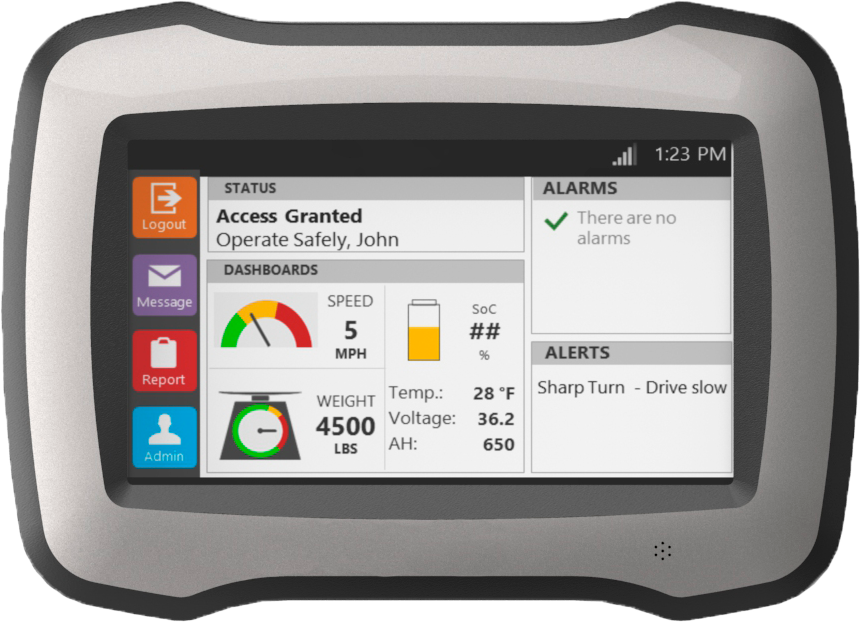THE CHALLENGE
In the US alone, there are over 855,000 forklifts, and 11% of those forklifts will be involved in an accident. According to OSHA, the fatal injury rate for the warehousing industry is higher than the national average for all industries.
There’s a lot of work to be done to make sure employees have a safe work environment. Around 70% of those accidents could’ve been avoided if proper training and policies were involved.
ON AVERAGE PER YEAR…
61,800
34,900
Accidents Resulting in Severe Injuries
85
Fatal Accidents
Operator & Safety
The most important employees in a warehouse or distribution center are the forklift operators. A good, well-trained driver assures safety in the workplace, efficient work performance, and a well-maintained forklift. All of these are essential to warehouse safety, operator safety, and safety and compliance of the company.
How to make your operation safer?

Training
The company can have a designated individual who is assigned to perform the training or it can outsource the task. If the company decides to keep training in-house, then the employee must be a certified trainer who is knowledgeable in the OSHA criteria.
The training process is not finished until the driver shows that he can properly operate the forklift in a safe manner. Only then can he be certified and assigned to drive a lift.

Safety Checklists
Telematics provides a customizable safety checklist to follow each time operator is going to drive a forklift.
The checklist will detail what the driver should check to determine if it is safe to drive.
Some sophisticated telematics devices can even lock down a lift until the checklist is fully completed and cleared to use. This ensures that the checklist is completed each and every time a vehicle is operated.

Optimize Operating Schedules
Using a telematics device, you can dig into usage reports to determine which vehicles are being most productive and which are sitting idle.
Redistribute vehicles that are not being used or eliminate unnecessary vehicles altogether. Not only will using a smaller number of vehicles ensure fewer accidents between equipment and their operators but using the ones you have more wisely will increase your overall productivity.

Load Sensing
Weight limits are rules to be strictly followed. First and foremost, every operator should be aware of the allowed weight that the vehicle can handle as well as the weight of the product.
Add an extra layer of protection, by installing a load sensing device that will detect if the load is heavier than allowed and send an alarm if so.
How Much Can Lack of Safety Cost Your Operation?
The current industry average is experiencing $188k in annual work-related injury costs (includes both direct and indirect costs), and failure to adhere to OSHA’s policies can result in fines ranging anywhere from $7k to $70k.
Even the smallest accident can impact your bottom line with increased downtime and maintenance costs.
OSHA Safety
Only trained and authorized operators shall be permitted to operate a powered industrial truck. Methods of training shall be devised to train operators in the safe operation of powered industrial trucks.
Since the promulgation of the OSHA standards, the consensus standard has undergone four complete revisions (dated 1975, 1983, 1988 and 1993). Here’s a summary for the current consensus standard (Ex. 3-1):
Operator Qualifications
Only trained and authorized persons shall be permitted to operate a powered industrial truck. Operators of powered industrial trucks shall be qualified as to visual, auditory, physical, and mental ability to operate the equipment safely according to operators training
Operator Training
Personnel who have not been trained to operate powered industrial trucks may operate a truck for the purposes of training only, and only under the direct supervision of the trainer. This training should be conducted in an area away from other trucks, obstacles, and pedestrians.
Training Program
The operator training program should include the user’s policies for the site where the trainee will operate the truck, the operating conditions for that location, and the specific truck the trainee will operate. The training program shall be presented to all new operators regardless of previous experience.
The training program shall inform the trainee that:
What the Program Needs to Inform
(a) The primary responsibility of the operator is to use the powered industrial truck safely following the instructions given in the training program.
(b) Unsafe or improper operation of a powered industrial truck can result in: death or serious injury to the operator or others; damage to the powered industrial truck or other property.
What the Program Needs to Teach
(a) Fundamentals of the powered industrial truck(s) the trainee will operate.
(b) Operating environment and its effect on truck operation.
(c) Operation of the powered industrial truck.
(d) Operating safety rules and practices.
(e) Operational training practice.


